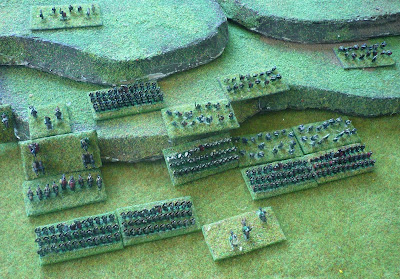Orders of Battle
Caledonians (from List II/60):
1 x General and chariots (LCh)
1 x Chariots (LCh)
8 x Warriors (3Wb)
2 x Javelinmen (Ps)
2 x Cavalry (LH)
Romans (from list II/56):
1 x General and cavalry (Cv)
1 x Equites (Cv)
4 x Legionaries (Bd)
4 x Auxiliary pedites (4Ax)
1 x Numidians (LH)
1 x bolt-shooters (Art)
Set-Up:
 |
| Romans at the bottom: Left - Cavalry, Front Centre - Auxiliaries, Centre - Legionaries, Rear - Light Horse, Right - Cavalry and Artillery |
 |
| The view from behind the Roman infantry |
 |
| Same situation, different angle |
 |
| The tide of battle turns against the Romans as they recoil down the slopes |
 |
| The Roman artillery has been eliminated by chariots and a unit of auxiliaries is destroyed too: the Romans are defeated! |
 |
| The situation at the end of the battle |
Game Notes:
Played on the same 3'x2' board, this game only took about 35 minutes of playing time. The key tactical difference in this game was that the Auxiliary vs Warband match-up in DBA is pretty even, whereas in Polemos SPQR and A&MW the Romans have a distinct advantage. The only place where warbands come off worse is in recoils but because of the advantages of slope and depth, they would have to be unlucky to lose in the first place. The PIP roll in DBA does provide some challenges but it is nowhere near as difficult as SPQR, especially for the Caledonian side: put simply in this game the Caledonian infantry could get into a deep formation in time, whereas in SPQR it just could not be co-ordinated in time. I played this in a semi "as history" fashion, but if playing as hard as possible, I would never have used Auxiliaries to lead such an attack, I would have reversed the positions of the Legionaries and the Auxiliaries. Blades against Warbands is a good match-up even with the slope in favour of the warbands. The playing experience isn't quite as simple as A&MW but it really rattles along - the lack of any attritional mechanism/buckets'o'dice/markers speeds up play (and gives a very smooth gaming experience). There are a lot more subtleties in the interactions of the troop types in DBA (of which there are more) which take more getting used to. And light troops are a bit harder to use effectively.
Figures from Baccus 6mm.
More DBA Reviews:
Ancient Wargaming
and Wall of Shields
andHistorical Wargaming Podcast


No comments:
Post a Comment